Colour TV (analogue - cathode ray tube). The image right is of a Matsui 14 inch TV showing a grey colour on the screen plus 'RT' as text. For older TV's like this model, the relatively coarse structure of the red-green-blue (RGB) phosphor can usually be seen by eye. The pattern may vary between screen type/age, some have a triad of RGB circular phosphors.
The brightness can vary within a discrete phosphor e.g. along the text borders in the image right. This can be compared with the digital displays shown below where a single colour picture element can only be a fixed brightness value.
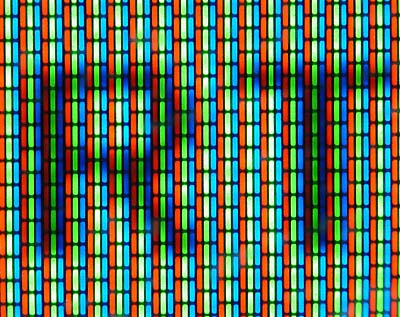
The letter 'R' is ca. 4.6 mm wide on the TV. Thus the discrete phosphor pitch is ca. 0.22 mm, and an RGB triplet ca. 0.65 mm wide.
Computer monitor (analogue - cathode ray tube). This analogue display has a higher resolution than the TV above, which is evident by the finer phosphor. This particular monitor (a 17 inch Taxan) has a Trinitron® tube with RGB phosphor stripes.
The base of a capital letter 'R' is shown. The horizontal line near the image bottom is one of the two fine 'damper wires' used to support the aperture grill of fine vertical wires. The damper wires are usually just visible to the naked eye when the screen is displaying e.g. an even white.
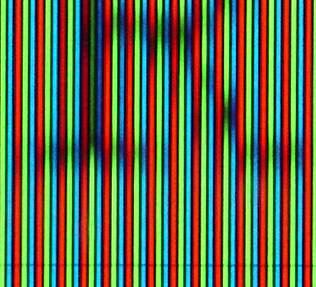
The letter 'R' base is ca. 3.25 mm wide. Thus the phosphor pitch is ca. 0.08 mm and an RGB triplet 0.25 mm wide. The maker's stated specification is a '0.25 mm aperture grill pitch'.
Laptop computer display (14 inch diagonal TFT screen, 1024x760 pixel native resolution). For a digital display such as this, each RGB 'subpixel' which makes up each pixel is a thin film transistor (TFT).
The screen fonts have been set for ClearType® in Windows XP Professional® which gives a more pleasing, less stepped edged text display.
Click here to read Microsoft's illustrated explanation of 'ClearType'.
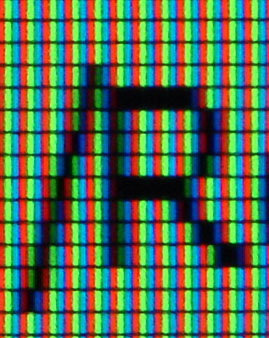
The screen shows a '/R'. The 'R' is ca. 1.5 mm wide. The RGB subpixel pitch is estimated from the screen specs. to be ca. 0.093 mm, and an RGB triplet which forms one pixel is ca. 0.28 mm wide. This screen is a little coarser than the analogue monitor above.
Some of the latest generation of laptop screens have a considerably better resolution, e.g. Dell state that their 'Inspiron 8600' with a 'WUXGA' screen has a native resolution of 1920x1200 pixels on a 16x10 inch screen, (suggesting the RGB triplet width is ca. 0.21 mm).
Digital camera LCD. This is the TFT display on a Canon Ixus 400 (S400), which has a 1.5 inch diagonal screen (31.5x23 mm, stated as 118,000 pixels).
The images right show increasing level of detail for the central house in the sensor display below. To give good images on the small screen requires a much higher density of subpixels cf. a laptop display. The densely packed subpixels are square cf. the laptop's rectangular elements.
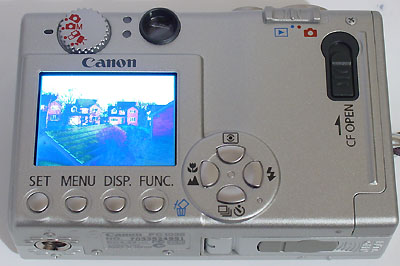
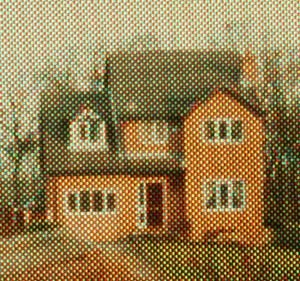
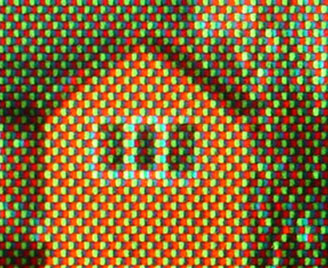
The subpixel pitch is estimated from the screen specs. to be 0.026 mm and each RGB triplet to form one pixel is ca. 0.078 mm wide. These pixels are densely packed cf. the PDA screen shown below.
The early PDA's were low resolution with typically 160x160 pixel displays. Some of the latest models have high resolution displays e.g. the Sony Clié TJ25 shown below. The 320x320 pixel screen is 54 mm², whereas at the above laptop's native screen resolution, 320x320 pixels occupies 89 mm². The PDA's high res. display makes the most of the image/text intensive software applications on a small screen.
Although this screen appears slightly coarser to the eye than the camera screen above, the subpixels are the smallest for the screens shown here because they are spaced apart vertically and more so horizontally.
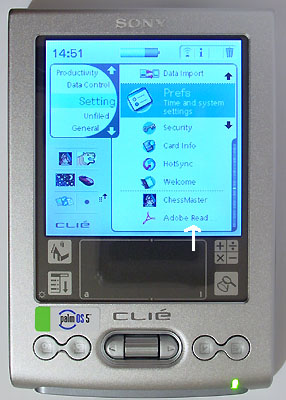
The small subpixels and diffusing action of the top screen makes it difficult to image with a digicam. But on the 3 megapixel setting and saving to tiff with the S75, it just manages to record a hint of the subpixel detail. A microscope is required to see the detail, see right.
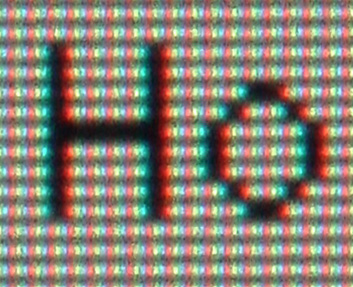
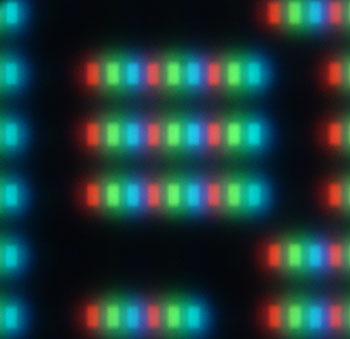
LOMO 9x/NA0.10 planachromatic microscope objective, no eyepiece, imaging with Sony S75 digicam. Focussed below the diffusing screen to the pixels below.
The central colour block in the image above is the white loop of the capital letter 'R' arrowed in the picture left. The glare is caused by the slight diffusing effect (intentional?) of the plastic cover of the interactive screen on which the styus pen is tapped.
From microscopy measurements, each subpixel is ca. 0.033x0.061 mm. The RGB subpixel pitch is ca. 0.055 mm, and an RGB triplet ca. 0.143 mm wide.
The widths of the repeating RGB phosphor and pixels are summarised below for the items described and demonstrates the advances in manufacturing capabilities and the requirements of a given screen.
TV
0.65 mm
Monitor 0.25 mm
Laptop 0.28 mm
Camera 0.078 mm
PDA
0.143 mm